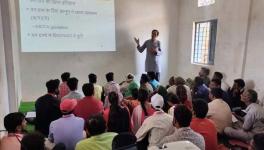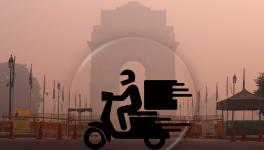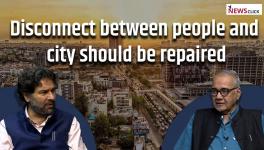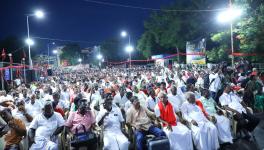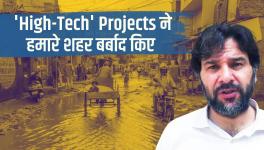Unsustainable Cities: Stop Piecemeal Approach, Constitute National Commission on Urbanisation
WILL the year 2021 be a secure future for all of us living in cities? This question haunts many of us who have been working in the cities since long. The year 2020 has been a thorough exposé on the way we are developing and imagining our cities. The Covid-19 pandemic that destroyed our economic structures and turned the situation into a holocaust has actually shed light on the hollowness of the building framework of our cities. The unsustainability of the cities came to the fore in a very vivid manner.
Such a system is completely fragile and we need to re-imagine the way in which we are building our urban centres. The arbitrary, irrational lockdown announced in a span of four hours and resulting in the reverse migration of urban workers, mostly from the unorganised sector, to their villages will go down in the annals of history as one of the biggest human tragedies.
But why is it that the cities that boasted of creating many indices for ranking on livelihood, sanitation, resilience and whatnot, could not just hold their poor, informal sector workers and other marginalised sections for even a few days? There are no easy answers to this question. However, one thing is quite immanent to it; and that is the processes and ways in which the cities are being developed without a connection to the demands of the people.
There is a transformation in the cities, which began long ago and this transformation, where cities are considered as ‘engines of growth’, and ‘entrepreneurs’, is actually linked to the need and vagaries of global finance capital. This process began in the early 70s in the world, and in the 90s in Indian cities. The policy paradigm was suggested to ensure that cities become competitive and investment-friendly.
Now, what does this mean in simpler terms? It means that the cities in order to sustain their infrastructure needs will have to ease out their laws; and since most of the laws concerning land, which is so pivotal for development, were either with the state or central government, pieces of central and state legislation were brought in. But a naïve question could be asked as to why should cities become competitive and why should the state and central government not invest in the cities?
According to the Jawaharlal Nehru National Urban Renewal Mission (JNNURM), from the reforms that were effected during the UPA 1 (United Progressive Alliance I) regime, which had the support of the Left, estimated a total of USD 630 billion is required to meet the infrastructure needs of urban India in a period of two decades. Guess what is the total money injected during that the 10 year period of UPA 1 and then UPA 2? It is mere 2.2% of this requirement. Mere USD 14 billion was planned to be injected in the cities through the JNNURM process, and most of these were project-oriented grants.
The figure itself gives us an idea of the gap that exists between the demand and the supply. Integrating with world capitalism, it was believed that the opening up of the economy would fetch capital in the cities only if easy access is allowed. This did not happen. We do not have a critical appraisal of the JNNURM; the fact remains that even those who advocated these reforms do not claim any legitimacy to the work done.
The large capital, which was believed to ameliorate our problems in the cities did not serve the purpose and instead, a nexus was generated at the centre and state levels, forcing the cities to accept the provisions of the reforms and allow a paradigm shift in urban governance.
How did this happen? Large consultancy firms got integrated with the Ministry of Urban Development at the Centre and then spread their fangs to the cities and created their plans, stating that the cities do not have the capacity to do so on their own and hence, such development plans will be devised by such firms. These plans were city developments plans, mobility plans, city sanitation plans, solar city plans, disaster risk reduction plans, solid waste management plans etc.
If a genuine review of these plans is done, one would find that most of these plans pushed for capital intensive technologies to enter the cities. Instead of solutions which are modest, cheaper and effected in a decentralised form, the inverse was suggested. Fine, but the question is where is the capital going to come from? I remember Vekaiah Naidu, former Union Urban Development Minister saying in a conference on cities: “The cities do not have money, they come to the states, the states also do not have money they come to the centre, the centre also does not have the required money, they look at the multilateral agencies.” These agencies, then, make their interventions not just in projects, but also in policies rolling out the development model, which is then eulogised by states and the cities. The states and cities are forced to implement these reforms because in case they do not then a large number of grants, which are linked to these reforms, are stopped.
2014 ONWARDS SITUATION WORSENS
With the Modi government coming to power in 2014, the cities, instead of witnessing a paradigm shift in urban policies, experienced the worst form of accentuation of the policies that led to further widening the gap of inequity. Smart Cities, AMRUT, Swachh Bharat Mission all of them were linked to the old model with stringent conditions. It was for hedgehog privatisation of cities without realising that this model was already failing. The addition of the Modi regime was that there was now a shift from privatisation of cities to privatisation of governance model as well.
The new model of governance in the cities through the smart cities concept brought in an adjunct of special purpose vehicle (SPV), which usurped the powers of the elected council. The council, which is supposed to take decisions, became paralysed with the SPV model as the major developmental projects were designed and decided by it. None of the elected members were decision-makers in the SPV, it is more of a bureaucrat or some financial expert-run institution with no accountability either to the people or the elected council.
In such a background, the cities have become centres of grinding the poor and extracting massive surplus, which gets appropriated into a few hands. Samuel Stien, in one of his pioneering works, The Capital City, writes that in a few American cities, the city development process has become the primary mode of capital accumulation. We are not sure if that is also true for Indian cities, but a cursory look at how the privatisation of utilities and services are affecting the livelihoods of the people, it is not too far that the process of city development becomes the primary mode of capital accumulation here as well!
This has led to a situation where the asset holding capacity of the marginalised and poor has been dwarfed phenomenally. In an Oxfam report, the top 10% and bottom 10% in rural India has a gap of nearly 500 times whereas in urban India the gap is mind-boggling 50,000 times. The poor just do not have any asset to hold onto in the cities. How can they sustain or how can such cities sustain without them?
WHAT NEEDS TO BE DONE?
I remember participating in a webinar discussion just recently where Kirtee Bhai, the lone living member of the first Urban Commission formed in 1986, of which Charles Correa was the chairperson, was emphatically quoting from the 2nd Habitat. The executive director of the 2nd UN Habitat time and again mentioned about the necessity of a revolution in the urban areas to ensure that the urban centres sustain. Of course, ‘revolution’ in the United Nations terminology has its own connotations. But at least a word that was missing from the vocabulary of many of the liberal urban theorists started to resonate.
Then we had the Habitat 3 in Quito in which I was also a delegate, and the executive director of Habitat III kept on reminding that the present model of urbanisation is unsustainable and that we have to go back to the basics. John Closs, the executive director of Habitat III vociferously raised his voice that “things, as usual, will not work”; he remarked that “the previous decades of laissez-faire i.e., the free-market economy has proven disastrous and that we have to go back to the basics of planning.” Now both these compiled together, what does it lead to?
It has very specific connotations, and the crux is that things must change and they must change in the interest of the people.
The first Urban Commission had presented interesting guidelines to the then government. The driving force or if one could say the preamble of this commission was driven by a fact that the cities were looked upon as centres of manufacturing. A major part of the objectives of this commission was to address this challenge in the cities.
The major role of this commission was to examine the state of urbanisation-demographic, economic, infrastructural, environmental, physical, energy, land, poverty, aesthetics and cultural aspects.
Its role was also to prepare basic guidelines for specific action plan in priority areas; evolve policy frames and suggest approaches to building interactions among government, academic, research and citizen groups.
Not just to limit to suggestions, but also suggest institutional framework for monitoring effective implementation of the commission’s recommendations.
The commission had made some recommendations that are worth sharing. It had recommended promoting 329 growth centres and emphasised upon strengthening the existing larger metropolis.
This was to be done through creation of employment, the opening of hinterlands, generating wealth with equity, cities to become catalysts of social transformation and modernisation of economy and society etc.
The commission also missed the cities and rather, brought in a vertical division from the centre, state to districts. However, it talked about spatial planning with a General Spatial Plan for a period of 10-15 years and an Integrated Spatial Plan for a period of five years.
Likewise, it suggested for plans on mobility, land use patterns and finances. However, 35 years down the line, this is not even discussed. Rather successive governments have followed a path of project-oriented development with abject surrender to private capital. This has not worked out as we all know.
In the given circumstance, what is required is to have a 2nd National Commission on Urbanisation to understand the complexities in our cities. When the first commission was formed, migration was not a big issue; likewise, the formal sector of employment was more than what it is today. The sheer numbers in the cities have grown phenomenally high. In the 80s, nearly 23% of the population stayed in urban centres; today, it is more than 34% (2001 - 31.8%). Since the 80s, nearly 218 million more people were added to the urban centres in the country (India’s urban population: 1981 -159 million, 2011 - 377 million). By the 2021 Census, the numbers would further swell.
The piecemeal approach to the problems of urban centres that includes, employment, city development, governance, utilities, the vitality of the town etc., cannot serve the purpose.
FORM 2ND NATIONAL COMMISSION ON URBANISATION
A 2nd National Commission should be entrusted with a task to formulate a holistic picture of the urban centres and the challenges. Small doses of “ease of doing business”, “smart cities”, AMRUT, etc., cannot bring in either quantitative or qualitative changes. But the point is who is going to do it?
With the present government is least interested to formulate such a commission. And we have seen in the past how a NUPF (National Urban Policy Framework) was halfheartedly designed that now the central government itself is not prepared to own its own document. In the given situation the people, and it means different sections of the people, will have to come and reclaim their spaces in the cities. Just like the kisans are reclaiming their rights, so will the other sections have to reclaim their right to plan their future by themselves and not to leave it to large tech giants.
Meanwhile, some of the states can formulate their state-level commissions to analyse the urban challenges and formulate action plans accordingly.
The year 2021 is a year of optimism as 2020 has not just been excruciatingly painful for many of us who have lost their close ones but also have continued to suffer because of the pandemic both pathologically and economically. This optimism for 2021 for, a year of fulfilling cherished dreams, will not and cannot fall like a fairy tale but will have to be achieved through our collective efforts for a better and secure future. And urban is part of that!
Get the latest reports & analysis with people's perspective on Protests, movements & deep analytical videos, discussions of the current affairs in your Telegram app. Subscribe to NewsClick's Telegram channel & get Real-Time updates on stories, as they get published on our website.












